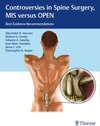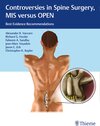
×
![Buchcover ISBN 9781638533290]()
Ärzte
Controversies in Spine Surgery, MIS versus OPEN
Best Evidence Recommendations
herausgegeben von Alexander R. Vaccaro und weiterenMaster spine surgeons Alexander R. Vaccaro, Richard G. Fessler, and a cadre of esteemed co-editors have compiled the most comprehensive textbook to date detailing minimally invasive spine (MIS) versus open spine surgery techniques. Controversies in Spine Surgery, MIS versus OPEN: Best Evidence Recommendations features debates by renowned experts on one of the most provocative topics in spine surgery. Twenty-four chapters systematically organized into four sections — degenerative, trauma, tumor, and other issues, cover procedures and underlying pathologies, backed by a large, diverse body of literature. MIS and open approaches are thoroughly compared and contrasted in each chapter. Evidence is presented and analyzed in an objective manner with 'opposing sides' presenting differing opinions and techniques, resulting in a synchronous collection of pros and cons. Every chapter is masterfully summed up by the book's editors — each of whom have varying stances on the topics at hand. This unique 'duel' and 'duet' discussion enables readers to assimilate information, benefit from the balanced harmony between divergent opinions, and reach their own conclusions. Key HighlightsComparative risks, benefits, complications, and outcomes for a full spectrum of lumbar, thoracic and cervical proceduresMIS versus open approaches for lumbar stenosis, synovial cysts, lumbar adjacent segment degeneration, degenerative scoliosis, flatback syndrome, thoracic disc herniation, and dural tearsTumor resection and stabilization, quality of life issues, and potential advantages and risks of MIS techniquesKey differences in MIS versus open operations such as radiation exposure and costsAnalysis of 3-D navigational imaging to improve outcomes and reduce radiation exposure and operating timeThis book is a tremendous, evidence-based tool to guide spine surgeons as they make important decisions on selecting the most optimal spine surgery techniques. It is a must-have resource for all resident and veteran orthopaedic surgeons and neurosurgeons who specialize in treating patients with spine conditions.




